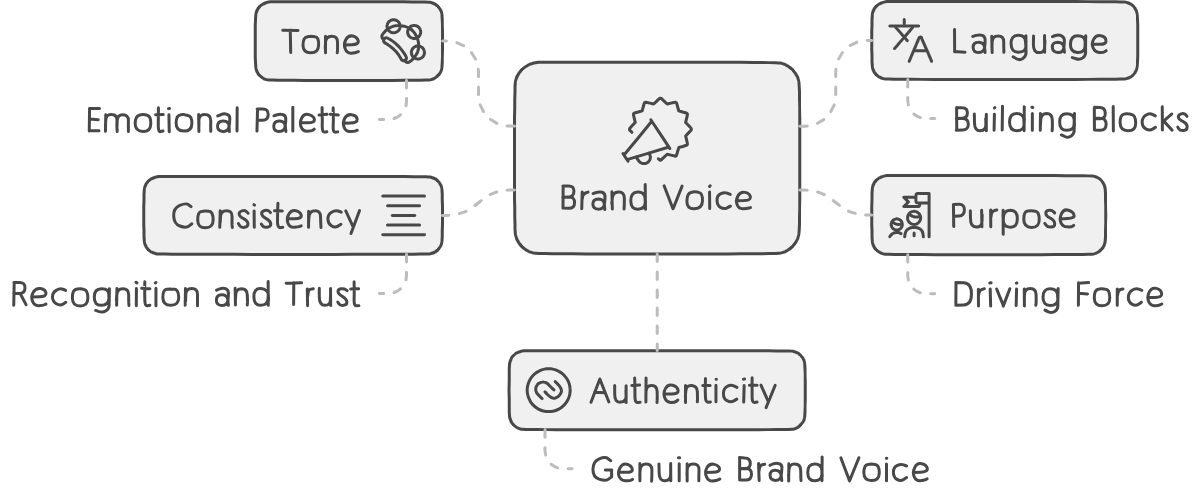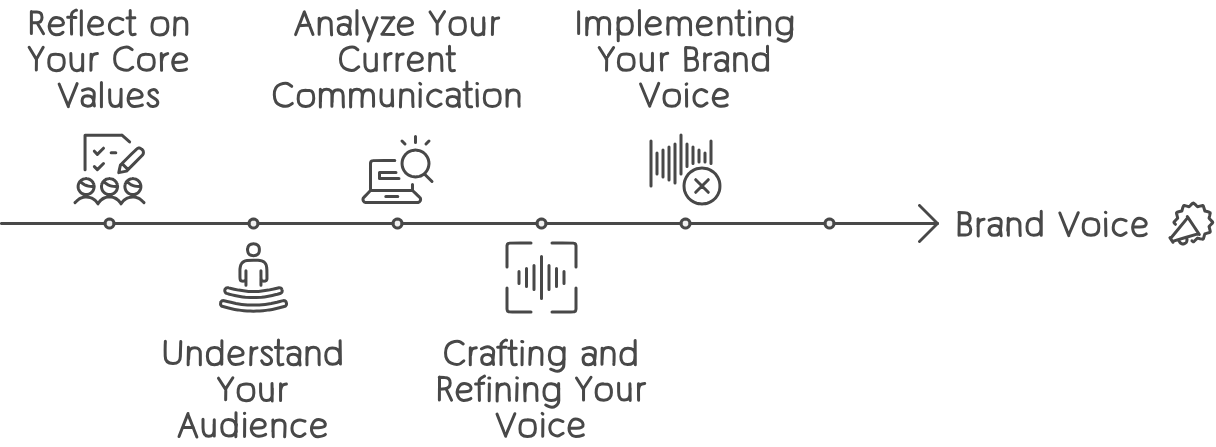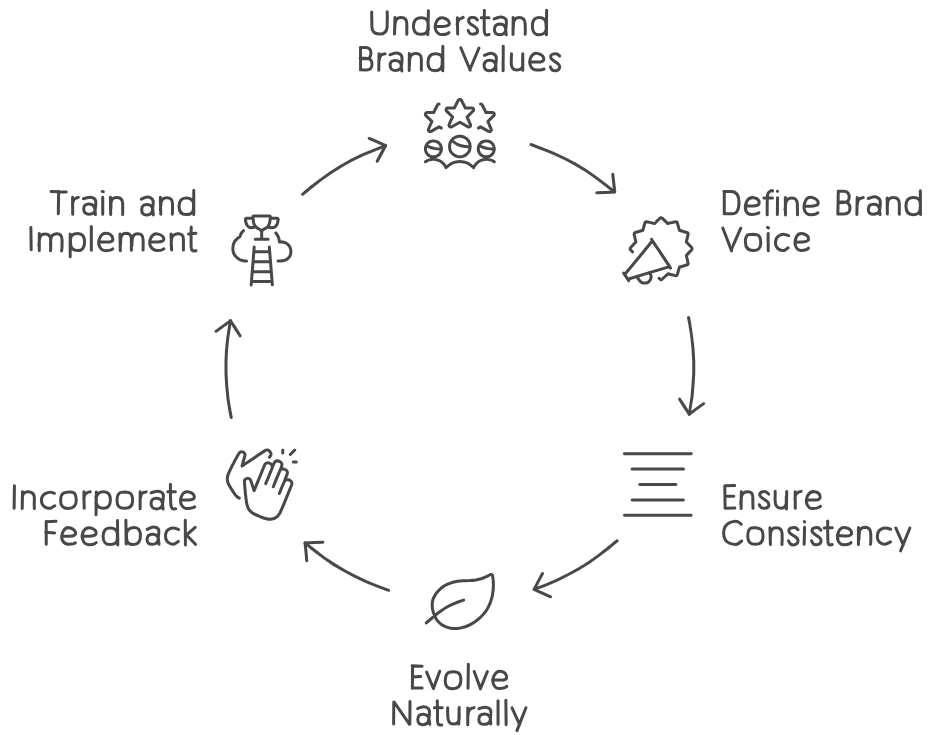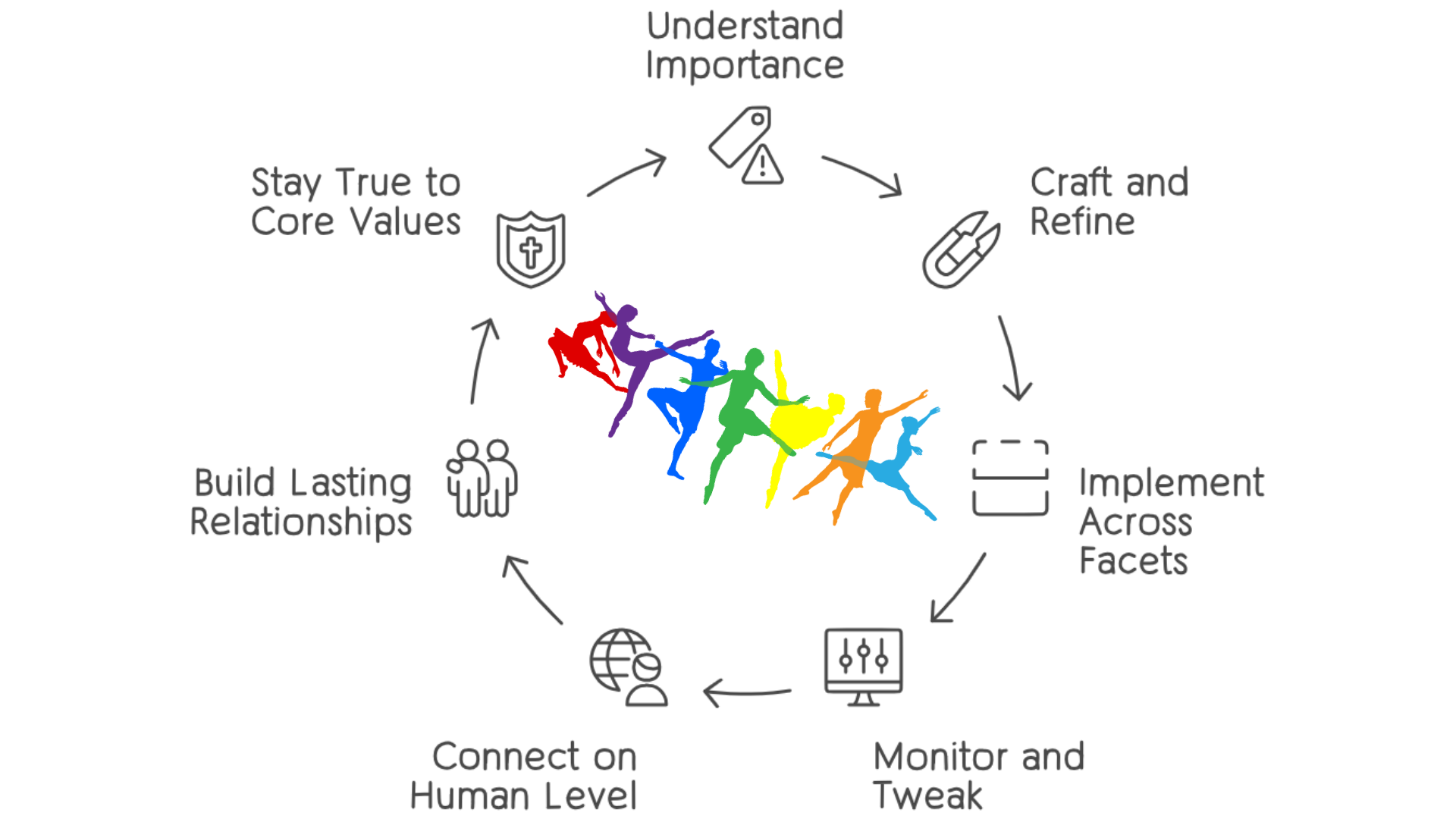Finding Your Brand Voice: Authenticity in Every Word

Introduction:
Have you ever heard a voice that you just couldn’t forget? It might have been soothing, dynamic, or so uniquely captivating that it left an indelible mark on your memory. Now, imagine your brand having that kind of voice – not just heard, but felt, creating a lasting impression in the minds and hearts of your audience.
In the bustling marketplace of ideas and commerce, your brand’s voice is not just a tool; it’s the essence of its personality and the bridge that connects you to your audience. It’s not merely about what you say, but how you say it. The right voice can turn heads, spark interest, and build a loyal community. But how do you find that voice? How do you ensure it’s not just another echo in the cacophony of the digital world, but a clear, authentic tone that resonates with your core audience?
In this journey, we’ll explore the power of a well-crafted brand voice. From the deep-seated reasons why it matters, to the practical steps of discovering and honing your unique brand voice, we’ll delve into the art and science of making your brand not just seen, but heard. And in a world where technology and AI like GPT are reshaping the landscape, we’ll also look at how these tools can amplify your brand’s voice, keeping it consistent and vibrant across all platforms.
So, let’s embark on this adventure to find your brand’s authentic voice, a voice that echoes your values, tells your story, and turns casual listeners into loyal advocates.
Table of Contents
Section 2: The Elements of an Authentic Brand Voice

When we speak of a brand’s voice, we’re not just talking about audio or text. We’re talking about the heart and soul of your brand’s identity. It’s how your brand ‘speaks’ to the world. This voice is made up of several key elements, each playing a crucial role in making it as authentic and compelling as possible.
1. Tone: The Emotional Palette of Your Brand
- The tone is the emotional inflection behind your brand’s communication. It’s the warmth in a friendly message, the authority in an informative article, or the excitement in a new product announcement.
- It’s essential to align your tone with your brand’s values and the emotions you want to evoke in your audience. Whether it’s professional, playful, inspirational, or something else, your tone sets the mood for every interaction.
Example: Consider a luxury spa brand using a calm, soothing tone in its communications versus a high-energy sports brand that uses an energetic and motivational tone.
Activity: Create a ‘Tone Mood Board’. Gather various advertisements, social media posts, and marketing emails from brands you admire. Note the emotional tone in each and how it aligns with their brand identity. Reflect on how you can emulate this in your brand’s tone.
2. Language: The Building Blocks of Communication
- Language is the choice of words and phrases you use. It’s about being relatable and understandable to your target audience.
- This involves choosing words that resonate with your audience while avoiding jargon that might alienate or confuse them. Your language should reflect the brand’s personality, whether it’s sophisticated, down-to-earth, technical, or artistic.
Example: A tech company might use more sophisticated, jargon-heavy language to appeal to a tech-savvy audience, whereas a family-oriented brand would use simple, warm, and inclusive language.
Activity: ‘Word Association Exercise’. List down words that you feel represent your brand. For each word, write down additional words that come to mind. This exercise helps in building a vocabulary that is unique to your brand’s language.
3. Purpose: The Driving Force Behind Your Words
- Every piece of communication should have a clear purpose. Are you trying to inform, persuade, entertain, or inspire? Your brand’s purpose should shine through in your messaging.
- This clarity of purpose ensures that your content is not just filling space but actively contributing to your brand’s goals and connecting with your audience on a deeper level.
Example: A health food brand’s purpose might be to educate and inspire healthy living, evident in content that offers health tips and nutritious recipes.
Activity: ‘Purpose Statement Workshop’. Write a clear, one-sentence purpose statement for your brand. Every time you create content, ask yourself if it aligns with this statement. If not, reconsider the content’s direction.
4. Consistency: The Key to Recognition and Trust
- Consistency in your brand voice helps build recognition and trust. It means that no matter where or how your audience encounters your brand, they receive the same underlying message and feel.
- This doesn’t mean every piece of content sounds the same, but rather that they all clearly come from the same source – your unique brand.
Example: Apple’s consistent use of sleek, minimalist design and language across all platforms contributes to its recognizable brand identity.
Activity: ‘Brand Voice Checklist’. Create a checklist of your brand voice attributes (tone, language, purpose). Review your recent content against this checklist to ensure consistency.
5. Authenticity: The Core of a Genuine Brand Voice
- Authenticity is about being true to who you are as a brand. It’s not about following trends or mimicking competitors; it’s about being honest and genuine in your communication.
- An authentic brand voice resonates with your audience because it’s relatable and trustworthy. It’s a voice that doesn’t just speak; it listens and responds to the audience’s needs and preferences.
Example: Patagonia’s authentic commitment to environmental activism is reflected consistently in its messaging, resonating with its audience.
Activity: ‘Authenticity Audit’. Review your past content and identify instances where your brand was most ‘yourself’ and where it wasn’t. Analyze why and how you can bring more authenticity to future communications.
Conclusion: A well-crafted brand voice is a symphony of tone, language, purpose, consistency, and authenticity. It’s a powerful tool that can elevate your brand from just another name in the market to a memorable and beloved presence in your customers’ lives. In the next sections, we’ll explore how to discover and refine these elements to create a brand voice that truly represents the heart of your business.
Section 3: Discovering Your Unique Brand Voice

Finding your brand’s voice is a journey of self-discovery for your business. It’s about digging deep to uncover what makes your brand truly unique and how to express that uniqueness through your communication. Let’s explore how to discover your unique brand voice, complete with examples and activities for a hands-on approach.
Reflect on Your Core Values
Your brand’s core values are the foundation of your brand voice. They influence the tone, language, and purpose of your communication.
Example: If one of your core values is “innovation,” your brand voice might be forward-thinking and pioneering, using language that conveys a sense of progress and future possibilities.
Activity: ‘Values Brainstorming Session’. List all the values that your brand stands for. Choose the top three that are most important and think of how these can influence your brand’s communication style. Write down adjectives that describe these values and how they could translate into tone and language.
Understand Your Audience
Knowing who you are speaking to is crucial. Your audience’s preferences, pain points, and language will shape your brand voice.
Example: A brand targeting busy professionals might opt for a concise, direct brand voice that respects their time, while a brand catering to creative individuals might use a more expressive and imaginative voice.
Activity: ‘Audience Persona Workshop’. Create detailed personas for your target audience, including demographics, interests, and behaviors. For each persona, write a brief message as if you were speaking directly to them. Notice how your language and tone shift with each persona.
Analyze Your Current Communication
Looking at your existing content can provide insights into your current brand voice and areas for refinement.
Example: Reviewing social media posts may reveal a casual, conversational tone that resonates well with your audience, suggesting a direction for future content.
Activity: ‘Content Audit’. Collect a wide range of your brand’s current content—social media posts, emails, blog articles, etc. Evaluate each piece for tone, language, and alignment with your core values. Identify what works well and what doesn’t, noting any discrepancies or inconsistencies.
Crafting and Refining Your Voice
Once you have a clear understanding of your values, audience, and current voice, it’s time to refine and formalize your brand voice.
Example: After identifying that authenticity and empowerment are key values resonating with your audience, you decide to adopt an inspiring and motivational tone, using empowering language across all communications.
Activity: ‘Voice Guidelines Creation’. Develop a brand voice guideline document that outlines your brand’s tone, language, and purpose. Include dos and don’ts, style preferences, and examples of how to use your brand voice across different mediums.
Implementing Your Brand Voice
Consistently applying your brand voice across all platforms and touchpoints is crucial for brand recognition.
Example: Ensure that from your website to your customer service interactions, the brand voice remains consistent, reinforcing your brand identity with each interaction.
Activity: ‘Voice Consistency Challenge’. Over the next month, focus on applying your brand voice guidelines to every piece of content created. Weekly, review the content with your team to ensure consistency and make adjustments as needed.
Conclusion:
Discovering and refining your brand voice is an ongoing process that requires attention and dedication. By understanding your core values, knowing your audience, analyzing your current communication, and consistently applying your unique voice, you’ll create a strong, authentic brand identity that resonates with your audience and stands out in the market.
Section 4: Crafting and Refining Your Voice

After laying the groundwork by understanding your brand’s core values, audience, and current communication style, it’s time to dive deeper into crafting and refining your brand voice to ensure it’s not only unique but also consistently resonates with your target audience. Here are detailed steps, examples, and activities to guide you through this process.
Create a Voice Chart
A voice chart is a visual tool that helps define and differentiate aspects of your brand voice across various dimensions, such as formality, enthusiasm, and sincerity.
Example: For a playful pet brand, the voice chart might emphasize a friendly and casual tone, using enthusiastic language, while a legal consultancy might focus on a more formal and reassuring tone.
Activity: ‘Build Your Brand Voice Chart’. On a large sheet of paper, draw a chart with axes representing different dimensions of voice (e.g., formal vs. casual, enthusiastic vs. reserved). Plot where your brand falls on these axes. Use this chart to guide content creation, ensuring it aligns with these defined characteristics.
Consistency is Key
Consistency in your brand voice builds trust and recognition. It means your audience will know it’s you, whether they’re reading an email, browsing your website, or scrolling through social media.
Example: A well-known coffee chain uses a consistent, conversational tone across all channels, making customers feel like they’re talking to a friend, whether in-store or online.
Activity: ‘Voice Consistency Audit’. Over a week, examine all the content your brand produces across different channels. Check for consistency in tone, language, and alignment with your brand values. Identify any discrepancies and plan corrective actions.
Evolve Naturally
As your brand grows, your audience might change, and your brand voice can evolve too. It’s important that this evolution feels natural and stays true to your core values.
Example: A technology company that started with a niche, tech-savvy audience may broaden its appeal over time, slightly adjusting its language to be more accessible while maintaining its innovative edge.
Activity: ‘Voice Evolution Workshop’. Annually, gather your marketing team to review your brand voice in light of any changes in your business or audience. Discuss what has changed and how your voice needs to adapt. Update your voice chart and guidelines accordingly.
Feedback Loop
Incorporating feedback from your audience and team is crucial in refining your brand voice. It ensures your voice remains relevant and resonant.
Example: A lifestyle brand regularly surveys its audience to get feedback on their communication style, discovering a desire for more inclusive and diverse language.
Activity: ‘Audience Feedback Collection’. Design a survey to collect feedback on your brand’s communication. Ask specific questions about tone, language, and overall perception. Use this feedback to make informed adjustments to your brand voice.
Training and Implementation
Ensuring your whole team understands and can implement your brand voice is essential for consistency across all touchpoints.
Example: A customer service team trained in the brand’s friendly and helpful voice provides a seamless brand experience, reinforcing the brand’s identity in every interaction.
Activity: ‘Brand Voice Training Session’. Host a training session for your team on the brand voice guidelines. Include practical exercises, such as rewriting content samples in the correct brand voice. Regularly review real-life examples from your brand’s communications to reinforce learning.
Conclusion:
Crafting and refining your brand voice is a dynamic and collaborative process. It involves defining clear guidelines, ensuring consistency, adapting to change, listening to feedback, and training your team. By engaging in these activities, you’ll develop a strong, authentic brand voice that not only distinguishes your brand but also deeply connects with your audience.
Section 5: Implementing Your Brand Voice
Now that you’ve crafted and refined your brand voice, the next crucial step is implementation. This involves consistently using your brand voice across all platforms and channels to ensure a cohesive brand experience. Here’s how to effectively implement your brand voice, with examples and activities to help guide you through the process.
Integrating Voice Across All Content
Your brand voice should be evident in everything from your website copy and blog posts to social media messages and customer service interactions.
Example: A health and wellness brand ensures its supportive and empowering voice is reflected in everything from its Instagram posts to its email newsletters and even its product descriptions.
Activity: ‘Content Alignment Workshop’. Gather samples of content from across your platforms. Break into teams and assess whether each piece aligns with your brand voice. Identify discrepancies and suggest revisions to align with your brand voice guidelines.
Training Your Team
For consistent implementation, it’s essential that your entire team understands and can apply the brand voice in their work.
Example: A technology company conducts regular training sessions for new employees on its brand voice, emphasizing clarity and approachability, and provides refresher courses for existing staff.
Activity: ‘Brand Voice Immersion Day’. Organize a day where team members from different departments create content relevant to their roles, using the brand voice guidelines. Review the content together, providing constructive feedback to reinforce understanding and application of the brand voice.
Utilizing Templates and Guides
Templates and guides can help ensure consistency, making it easier for your team to produce content that aligns with your brand voice.
Example: A boutique hotel chain uses templates for social media posts and customer responses that reflect its warm, welcoming brand voice, ensuring consistency across all properties.
Activity: ‘Template Creation Challenge’. Have team members develop templates for common types of communication in their areas, such as email responses, social media posts, and blog articles. Share these templates company-wide as a resource.
Monitoring and Feedback
Continuous monitoring and soliciting feedback are vital to maintaining a consistent brand voice and making necessary adjustments.
Example: A fashion retailer regularly reviews customer feedback on its communications, paying close attention to how its playful and inclusive brand voice is received, and adjusts based on this feedback.
Activity: ‘Voice Feedback Loop’. Implement a monthly review process where you gather customer feedback specifically about communication style and brand voice. Use surveys, social media comments, and customer service interactions as sources of feedback.
Evolving with Your Audience
As your audience grows and changes, your brand voice may need to evolve to continue resonating with them.
Example: An organic food company noticed a shift in its audience’s values towards sustainability, prompting it to emphasize this more in its compassionate and informative brand voice.
Activity: ‘Audience Evolution Workshop’. Annually, analyze changes in your audience demographics, interests, and feedback. Discuss how your brand voice can evolve to keep pace, and plan a strategy for gradually implementing these changes.
Conclusion:
Implementing your brand voice is an ongoing effort that requires dedication across your organization. By integrating your voice across all content, training your team, using templates, monitoring feedback, and evolving with your audience, you can ensure that your brand voice remains strong, consistent, and resonant. This not only enhances your brand’s identity but also deepens the connection with your audience.
Section 6: Measuring the Impact of Your Brand Voice
After implementing your brand voice across all channels, it’s essential to measure its impact. This helps you understand how well your brand voice resonates with your audience and guides future communication strategies. Here are key areas to focus on, along with examples and activities for effectively measuring your brand voice’s impact.
Analyzing Engagement Metrics
Engagement metrics such as likes, shares, comments, and time spent on your content can provide insights into how your audience is responding to your brand voice.
Example: A lifestyle brand notices that its blog posts, written in a conversational and witty brand voice, consistently receive higher engagement compared to more formal content.
Activity: ‘Engagement Analysis’. Collect engagement data from your various platforms over a set period. Identify patterns and correlations between high engagement and specific aspects of your brand voice. Use this data to refine your content strategy.
Conducting Surveys and Polls
Direct feedback from your audience through surveys and polls can give you a clear picture of how your brand voice is perceived.
Example: An eco-friendly product company conducts a customer survey and discovers that its passionate and educational brand voice is a key reason customers feel loyal to the brand.
Activity: ‘Voice Perception Survey’. Design and distribute a survey asking your audience how they perceive your brand voice and how it influences their view of your brand. Include questions that gauge emotional resonance, clarity, and alignment with brand values.
Monitoring Brand Sentiment
Brand sentiment analysis involves evaluating the emotions and opinions expressed in mentions of your brand across social media, reviews, and other digital platforms.
Example: A tech startup uses social media monitoring tools to track sentiment and notices an uptick in positive sentiment when it adopts a more helpful and less technical brand voice in its communications.
Activity: ‘Sentiment Tracking Project’. Use a social media monitoring tool to track mentions of your brand and analyze the sentiment over time. Look for trends related to changes in your brand voice and identify areas for improvement.
Reviewing Customer Feedback
Customer feedback, whether through reviews, customer service interactions, or direct communications, can offer valuable insights into how your brand voice is resonating.
Example: A restaurant chain reviews feedback from customer service emails and finds that customers appreciate the friendly, personable tone, which makes them feel more connected to the brand.
Activity: ‘Customer Feedback Review Session’. Regularly collect and review customer feedback focusing on language and tone. Look for comments that specifically mention your communication style, and use this feedback to assess the effectiveness of your brand voice.
A/B Testing
A/B testing involves comparing two versions of your content with slight variations in brand voice to see which performs better in terms of engagement and conversion.
Example: An online retailer experiments with two tones of voice in its product descriptions: one playful and one professional. It finds that the playful tone leads to a higher conversion rate for certain products.
Activity: ‘Brand Voice A/B Testing’. Choose a piece of content, create two versions that vary only in tone or language, and measure which version achieves better engagement or conversion rates. Use these results to inform your content strategy.
Conclusion:
Measuring the impact of your brand voice is crucial for understanding its effectiveness and making data-driven decisions to refine your communication strategy. By analyzing engagement metrics, conducting surveys, monitoring brand sentiment, reviewing customer feedback, and performing A/B testing, you can gain valuable insights into how your brand voice influences your audience and business outcomes. This continuous loop of implementation, measurement, and refinement ensures your brand voice remains a powerful asset in connecting with your audience.
Section 7: Leveraging AI Tools like GPT for Your Brand Voice
Introduction to AI in Branding: Introduce the concept of using AI tools like GPT for enhancing brand voice strategies.
How GPT Can Assist in Brand Voice Development:
- Content Analysis: Explain how GPT can analyze existing content to identify and replicate the brand’s voice.
- Consistency Across Platforms: Discuss the role of AI in maintaining a consistent voice across various channels.
- Speed and Efficiency: Highlight how GPT can streamline content creation while keeping the brand voice intact.
Loading Content Samples into GPT:
- Step-by-Step Guide: Provide a simple guide on how to input brand-specific content samples into GPT.
- Customization and Learning: Explain how GPT learns from these samples to generate content that aligns with the brand’s established voice.
Creating a Brand or Character with GPT:
- Defining Characteristics: Guide the reader on defining the characteristics and traits of their brand or character.
- Feeding Information to GPT: Illustrate how to feed this information to GPT to create consistent and on-brand content.-
- Examples and Case Studies: Share success stories or case studies where GPT has been used effectively to maintain or establish a brand voice.
Ethical Considerations and Authenticity:
- Balancing AI and Human Touch: Discuss the importance of maintaining authenticity and not over-relying on AI.
- Ethical Use of AI in Branding: Briefly touch on the ethical considerations and best practices in using AI tools like GPT.
Conclusion: Summarize the potential of GPT in enhancing and maintaining a brand voice, while emphasizing the need for a balance between technology and human creativity.
Interactive Element (Optional): Invite readers to share their thoughts or experiences using AI tools for brand voice development, fostering a community-driven conversation.
Conclusion: The Symphony of Authenticity – Harmonizing Your Brand Voice

As we reach the finale of our exploration into finding and refining your brand voice, it’s clear that this journey is both an art and a science. Your brand voice, much like a signature melody, has the power to linger in the minds and hearts of your audience, making every communication not just heard, but felt. It’s this emotional resonance that transforms casual browsers into loyal customers, and indifferent observers into passionate advocates.
From the initial steps of understanding the importance of an authentic brand voice, to the intricate process of crafting, refining, and implementing it across all facets of your communication, each phase is crucial. The exercises and examples provided are your instruments in this symphony, designed to help you conduct your brand’s unique score with precision and grace.
But remember, the work doesn’t stop with implementation. The true measure of your brand voice’s effectiveness lies in its impact—how it resonates with your audience, reflected in engagement, sentiment, and ultimately, in the success of your brand. Continuously monitoring and tweaking your brand voice ensures it grows with your brand, staying relevant and resonant in an ever-evolving market.
In this dynamic dance between your brand and its audience, authenticity remains your guiding star. It’s the authenticity of your brand voice that will cut through the noise, connect on a human level, and build lasting relationships. As you move forward, keep listening to your audience, stay true to your brand’s core values, and let your brand voice be a true reflection of who you are.
So, take these insights, tools, and exercises, and start conducting your brand’s symphony. Your audience is listening, ready to be moved by the authentic voice of your brand. Let it be one they’ll never forget.